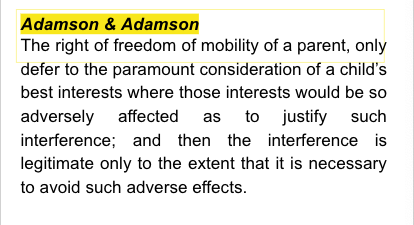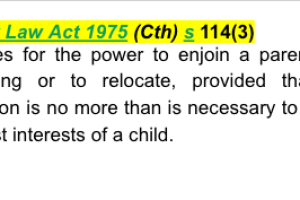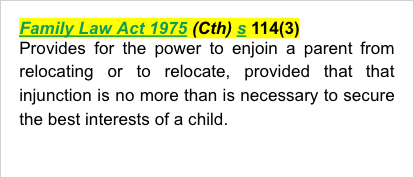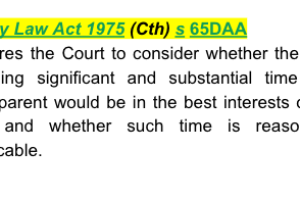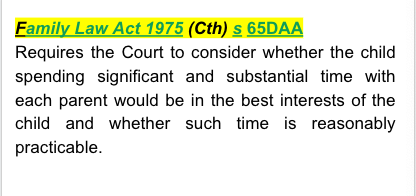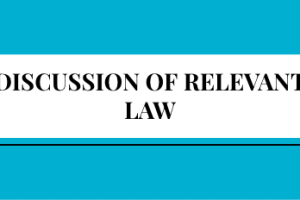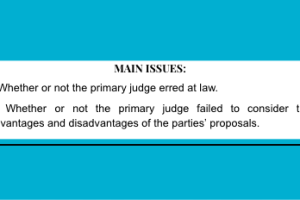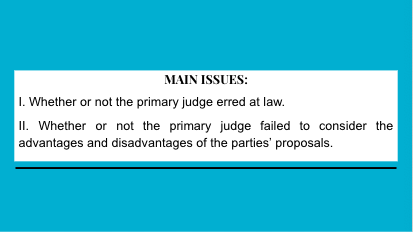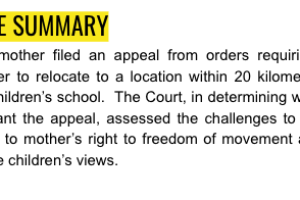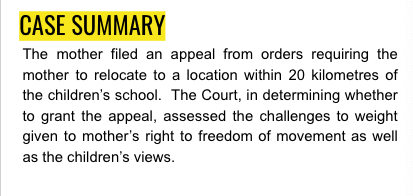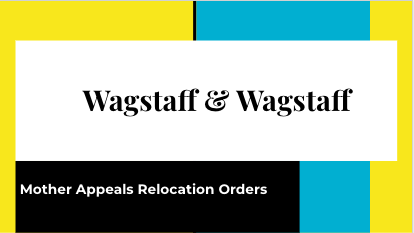- · 4760 friends
Mother Appeals Relocation Orders

Wagstaff & Wagstaff [2022] FedCFamC1A 119 (2 August 2022)

The mother filed an appeal from orders requiring the mother to relocate to a location within 20 kilometres of the children’s school. The Court, in determining whether to grant the appeal, assessed the challenges to weight given to the mother’s right to freedom of movement as well as the children’s views.

Facts:
This litigation concerned parenting orders in relation to two boys, one born in 2011 (now 10) and one born in 2014 (now 7). The boys’ parents have been embroiled in litigation since 2016. The primary judge was of the view that each parent loved the boys very much and, in the particular style of each, wanted what each thought was best for the children in circumstances where each parent had very different parenting styles. Before the primary judge were two main issues. The first was whether the mother should be permitted to remain living in the suburb of Town D, there being changes required to the children’s schooling if she did.
The time the children spend with their father was also affected by the mother remaining in Town D. The second issue was whether the mother should be required to move back to the suburb of Town A where she, the children and the father lived for several years. The mother moved to Town D to reside with her partner. The travelling distance between Town D and Town A was at least one hour one way or longer if traffic was heavy. The primary judge made orders requiring the mother to take up residence at a place of her choosing within 20 kilometres of the school attended by the children.
The primary judge made orders for both parents to have equal shared parental responsibility and the primary judge made orders for the children to live with the mother. A detailed regime was ordered for the children to spend time with the father. The mother complained, among others, that the primary judge (a) erred by failing to consider s 65DAA(2) of the Family Law Act; (b) effectively made a mandatory injunction in requiring the mother to live within a prescribed distance from the children’s school; (c) failed to adequately assess the mother’s right to freedom of movement; and (d) provided inadequate reasons.
The mother asserted that the primary judge failed to consider the advantages and disadvantages of the parties’ proposals and any alternative options to those proposals. The father submitted that when read as a whole, the reasons of the primary judge revealed a consideration of all proposals, variations and alternatives.

Issues:
I. Whether or not the primary judge erred at law.
II. Whether or not the primary judge failed to consider the advantages and disadvantages of the parties’ proposals.

Applicable law:
Family Law Act 1975 (Cth) s 65DAA - requires the Court to consider whether the child spending significant and substantial time with each parent would be in the best interests of the child and whether such time is reasonably practicable.

Family Law Act 1975 (Cth) s 114(3) - provides for the power to enjoin a parent from relocating or to relocate, provided that that injunction is no more than is necessary to secure the best interests of a child.

Adamson & Adamson (2014) FLC 93-62, [2014] FamCAFC 232 - provides that the right of freedom of mobility of a parent, only defer to the paramount consideration of a child’s best interests where those interests would be so adversely affected as to justify such interference; and then the interference is legitimate only to the extent that it is necessary to avoid such adverse effects.

Smethurst v Commissioner of Police (2020) 94 ALJR 502; [2020] HCA 14 - provides that the conventional dichotomy in the classification of injunctions in equity is the prohibitory injunction on the one hand and the mandatory injunction on the other hand.
Analysis:
The mother’s right to freedom of movement was taken into account and given significant, but not determinative, weight. In the mother’s submissions, it was put that children “often don’t know what’s good for them, and they often, of course, only know a very limited aspect of the conundrum which everybody faces”.
That is hardly a submission that the children have a lack of maturity or understanding for their age. However, the primary judge did not need to analyse matters that were not raised.
The mother asserted that in making the order requiring her to live within 20 kilometres of the children’s primary school in Town A so as to perform the primary parenting role in circumstances not of her choosing, the primary judge made an injunctive order pursuant to s 114(3) that was not proper. The primary judge carefully explained that the order (colourfully, but erroneously, described by the mother’s counsel as a “coercive order”) requiring the mother to move was premised on the welfare of the children.
The primary judge carefully weighed the evidence about the children’s connection with their school and their happiness when attending it. The primary judge also recognised the Family Consultant’s evidence to the effect that the mother will be unhappy if required to move and that any such unhappiness could very well lead to deleterious consequences on her parenting.
The primary judge found that the children were highly connected to their school. The mother pursued her romantic interest with her partner in a location 32 kilometres from the children’s school. She moved herself and the children, with neither forewarning to nor consent from the father then she resisted returning the children to the location with which they were most familiar and comfortable.
Of course, the mother enjoys freedom of movement. But when her choice of residence for herself and her children is inconsistent with the best interests of her children in respect of whom she is the primary carer, her choice of residence must be subordinated to the best interests of the children.
Conclusion:
The appeal is dismissed. No errors were established in the primary judge's reasons which were likewise proven adequate.



